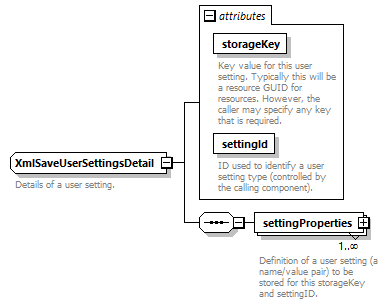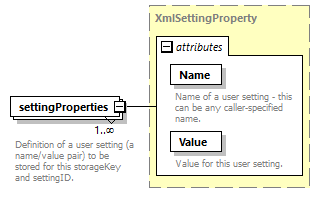| diagram |  |
||||||||||||||||||||||
| namespace | http://usersettingsservice.api.de.n2.tibco.com | ||||||||||||||||||||||
| children | settingProperties | ||||||||||||||||||||||
| attributes |
|
||||||||||||||||||||||
| annotation |
|
||||||||||||||||||||||
| source | <xs:complexType name="XmlSaveUserSettingsDetail"> <xs:annotation> <xs:documentation>Details of a user setting.</xs:documentation> </xs:annotation> <xs:sequence> <xs:element name="settingProperties" type="XmlSettingProperty" maxOccurs="unbounded"> <xs:annotation> <xs:documentation>Definition of a user setting (a name/value pair) to be stored for this storageKey and settingID.</xs:documentation> </xs:annotation> </xs:element> </xs:sequence> <xs:attribute name="storageKey" type="xs:string" use="required"> <xs:annotation> <xs:documentation>Key value for this user setting. Typically this will be a resource GUID for resources. However, the caller may specify any key that is required.</xs:documentation> </xs:annotation> </xs:attribute> <xs:attribute name="settingId" type="xs:string" use="required"> <xs:annotation> <xs:documentation>ID used to identify a user setting type (controlled by the calling component).</xs:documentation> </xs:annotation> </xs:attribute> </xs:complexType> |
attribute XmlSaveUserSettingsDetail/@storageKey
| type | xs:string | ||
| properties |
|
||
| annotation |
|
||
| source | <xs:attribute name="storageKey" type="xs:string" use="required"> <xs:annotation> <xs:documentation>Key value for this user setting. Typically this will be a resource GUID for resources. However, the caller may specify any key that is required.</xs:documentation> </xs:annotation> </xs:attribute> |
attribute XmlSaveUserSettingsDetail/@settingId
| type | xs:string | ||
| properties |
|
||
| annotation |
|
||
| source | <xs:attribute name="settingId" type="xs:string" use="required"> <xs:annotation> <xs:documentation>ID used to identify a user setting type (controlled by the calling component).</xs:documentation> </xs:annotation> </xs:attribute> |
element XmlSaveUserSettingsDetail/settingProperties
| diagram |  |
||||||||||||||||||||||
| type | XmlSettingProperty | ||||||||||||||||||||||
| properties |
|
||||||||||||||||||||||
| attributes |
|
||||||||||||||||||||||
| annotation |
|
||||||||||||||||||||||
| source | <xs:element name="settingProperties" type="XmlSettingProperty" maxOccurs="unbounded"> <xs:annotation> <xs:documentation>Definition of a user setting (a name/value pair) to be stored for this storageKey and settingID.</xs:documentation> </xs:annotation> </xs:element> |
WSDL documentation generated by XMLSpy WSDL Editor http://www.altova.com/xmlspy